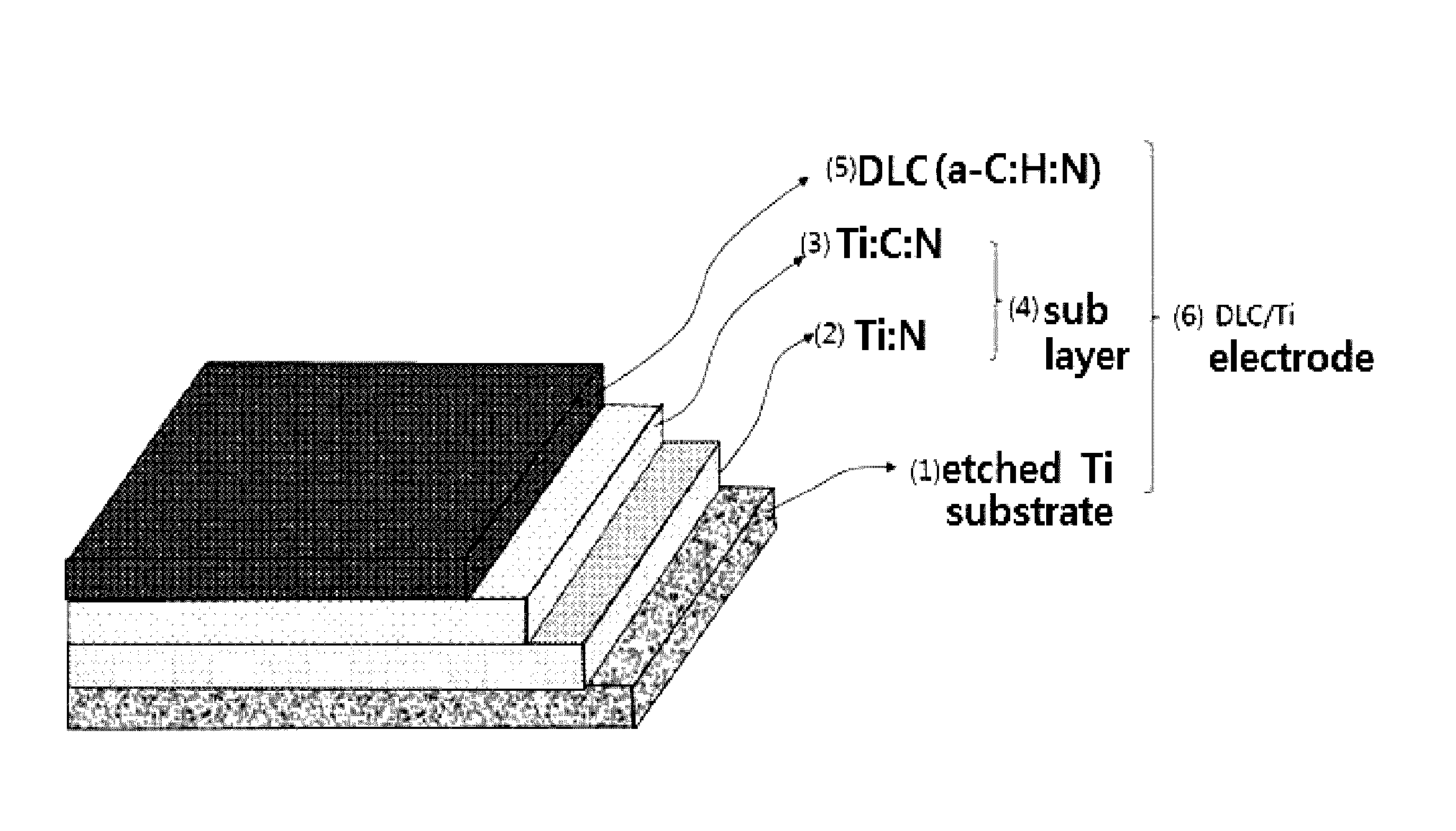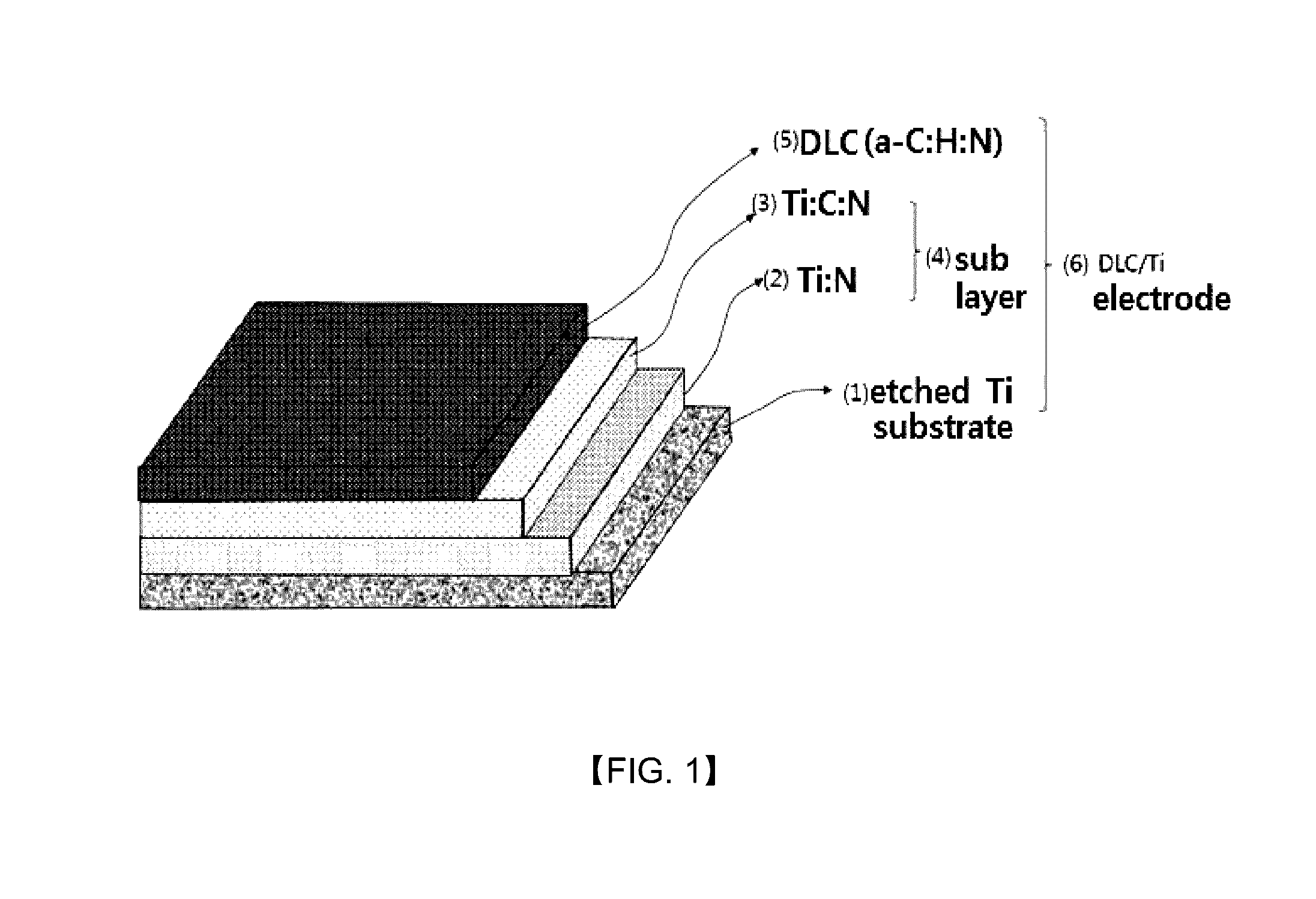Fabrication method of DLC/Ti electrode with multi-interface layers for water treatment
a technology of ti electrodes and fabrication methods, which is applied in the direction of non-conductive materials with dispersed conductive materials, etc., can solve the problems of high price of ti electrodes, limited commercial utilization, and high corrosion of ti electrodes, and achieve high mechanical hardness and chemical stability, high hardness of dlc and conductivity, and high adhesion
- Summary
- Abstract
- Description
- Claims
- Application Information
AI Technical Summary
Benefits of technology
Problems solved by technology
Method used
Image
Examples
example 1
[0070]For the manufacture of the DLC / Ti electrode with multilayer structure sublayer with electrochemical traits as in this invention, the Ti substrate shot-blasted to have surface roughness is deposited DC-PECVD (DC-plasma enhanced chemical vapor deposition) reactor of in 250 to 350° C., ideally 300° C., the degree of vacuum of 0.01 to 0.001 torr, and ideally approximately 0.0005, and first of all for the cleansing and surface etching of Ti substrate (1), Ar ion bombardment and plasma etching is conducted for several minutes (1 to 10 minutes, ideally t minutes), and afterwards, for the formation of nitrified layer (here Ti:N layer (2), the gas combining inert gas and nitrogen gas in volume proportions of 5-7:1 percent is inserted to deposit for 1 to 10 minutes. The nitrified layer of 10 to 100 nm thickness is formed. In this example, Ar 95 sccm, N2 15 sccm combined gas was inserted to deposit for 3 minutes.
[0071]Next, to form the combined coating layer of C and N, inert gas, nitrog...
example 2
[0077]To see the electrochemical traits before and after annealing of the DLC / Ti electrode with multilayer sublayer, the manufactured DLC / Ti was set as positive pole, Pt as negative pole, and the SSE (Ag / AgCl (Siver / Siver chloride) as reference electrode to utilize electrolyte of 3M KCl to measure CV (cyclic voltammogram). The FIG. 4 depicts the CV measurement at 20V / sec in 0.5M Na2SO4 solution to view the electrochemical potential window causing oxygen and hydrogen according to the annealing of the DLC / Ti electrode. Electrodes not heat-treated are dominated by the C-sp3 structure within the DLC structure that tough it has high coating hardness, it had high specific surface area resistance, and low background current. However, when heat-treated, the N structures of Ti:N, Ti:C:N installed as sublayer is transferred to within the DLC of a-C:H structure that part of it changes to a-C:H:N structure, and due to the decrease of specific resistance of the electrode surface, the background ...
example 3
[0079]The examples to compare the DLC / Ti electrode heat-treated at 800° C. for the optimal electrochemical activation, and the electrochemical traits BDD GC, Pt / Ti electrode are shown in FIGS. 7 and 8. FIG. 7 shows the example of measuring and comparing 20 mV / sec in 0.5M Na2SO4 solution to see the electrochemical potential window occurring the oxygen and hydrogen of the compared electrodes are seen. The BDD, GC, and DLC electrodes, which are all carbon electrodes have high overvoltage to hydrogen compared to Pt electrode, and the heat-treated DLC / Ti electrodes have wider electrochemical potential window in which oxygen and hydrogen occurs compared go GC, and have smaller potential window compared to BDD. FIG. 8 shows the CV measurement at 2-mV / sec to see the CV changes at 0.5 M Na2SO4 solution of 50 mV K4Fe(CN)6 to see the CV changes at Fe(CN)6 3- / Fe(CN)6 4-. The CV of the DLC / Ti electrode heat treated at 800° C. and BDD, Pt / Ti is almost similar and minute, but the DLC / Ti electrode ...
PUM
| Property | Measurement | Unit |
|---|---|---|
| temperature | aaaaa | aaaaa |
| thickness | aaaaa | aaaaa |
| resistivity | aaaaa | aaaaa |
Abstract
Description
Claims
Application Information
 Login to View More
Login to View More - R&D
- Intellectual Property
- Life Sciences
- Materials
- Tech Scout
- Unparalleled Data Quality
- Higher Quality Content
- 60% Fewer Hallucinations
Browse by: Latest US Patents, China's latest patents, Technical Efficacy Thesaurus, Application Domain, Technology Topic, Popular Technical Reports.
© 2025 PatSnap. All rights reserved.Legal|Privacy policy|Modern Slavery Act Transparency Statement|Sitemap|About US| Contact US: help@patsnap.com



